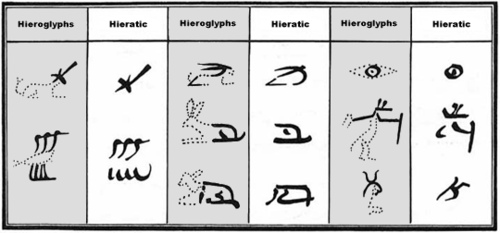
FAIR is a non-profit organization dedicated to providing well-documented answers to criticisms of the doctrine, practice, and history of The Church of Jesus Christ of Latter-day Saints.
FAIR Answers—back to home page
| Chapter 11 - DNA | A FAIR Analysis of: For my Wife and Children (Letter to my Wife), a work by author: Anonymous
|
Chapter 13 - Anachronisms |
the Church teaches that the civilizations of the Book of Mormon wrote in a language called “reformed Egyptian”
And now, behold, we have written this record according to our knowledge, in the characters which are called among us the reformed Egyptian, being handed down and altered by us, according to our manner of speech.
And if our plates had been sufficiently large we should have written in Hebrew; but the Hebrew hath been altered by us also; and if we could have written in Hebrew, behold, ye would have had no imperfection in our record
Moroni makes it clear that "reformed Egyptian" is the name which the Nephites have given to a script based upon Egyptian characters, and modified over the course of a thousand years (See Mormon 9:32). So, it is no surprise that Egyptians or Jews have no script called "reformed Egyptian," as this was a Nephite term.
There are, however, several variant Egyptian scripts which are "reformed" or altered from their earlier form. Hugh Nibley and others have pointed out that the change from Egyptian hieroglyphics, to hieratic, to demotic is a good description of Egyptian being "reformed." By 600 BC, hieratic was used primarily for religious texts, while demotic was used for daily use.off-site
One can see how hieroglyphics developed into the more stylized hieratic, and this process continued with the demotic:

What could be a better term for this than an Egyptian script that has been "reformed"?
More recent research provides further corroboration:
The fourth presentation at BYU’s Willes Center for Book of Mormon Studies conference on 31 August 2012 was on “Writing in 7th Century BC Levant,” by Stefan Wimmer of the University of Munich. It was entitled “Palestinian Hieratic.” He examined an interesting phenomena in Hebrew inscriptions, the use of Egyptian hieratic (cursive hieroglyphic) signs.
Basically Hebrew scribes used Egyptian signs for various numerals, weights and measures. The changes in the form of these signs parallel similar chronological changes in the form of Egyptian hieratic characters, which indicates continued contact of some sort between Egyptian and Hebrew scribes, probably over several centuries. (If there had been a single scribal transmission with no ongoing contact, the changes in the Hebrew forms of hieratic signs would not parallel contemporary changes in Egyptian hieratic forms.) No other Semitic language used Egyptian hieratic signs except Hebrew (with one possible Moabite example.)
There are a couple of hundred examples of such texts, the majority dating from the late seventh century, and geographically mainly from Jerusalem southward. The phenomena ends after the Babylonian captivity. (In other words, Palestinian hieratic is most common in precisely the time and location of Lehi and Nephi, and only exists in Hebrew.)[1]
Additionally,
Documents from the kingdoms of both Israel and Judah, but not the neighboring kingdoms, of the eighth and seventh centuries contain Egyptian hieratic signs (cursive hieroglyphics) and numerals that had ceased to be used in Egypt after the tenth century (Philip J. King and Lawrence E. Stager, Life in Biblical Israel (Louisville, Kentucky: Westminster John Knox Press, 2001), 311.)
German Egyptologist Stefan Wimmer calls this script "palestinian Hieratic." See Stefan Wimmer, Palästinisches Hieratisch: Die Zahl- und Sonderzeichen in der althebräischen Schrift, Ägypten und Altes Testament 75 (Germany: Harrassowitz Wiesbaden, 2008).
William Hamblin provides additional example of such reformation of Egyptian, including:
Given that Moroni says the Nephites then modified the scripts further, "reformed Egyptian" is an elegant description of both the Old World phenomenon, and what Moroni says happened among the Nephites.
The Church claims that Lehi’s family used a writing system called ‘reformed Egyptian’ and after the destruction of the Nephites, the Lamanites are supposed to have taken this language and spread throughout both American continents and the Pacific islands.
1) Lehi's family did not write in "reformed Egyptian". Mormon and Moroni (who were Nephites) used it to abridge all of the earlier records 1000 years after Lehi's time. 2) Neither the Book of Mormon nor the Church teaches or makes any sort of claim that the Lamanites ever used the "reformed Egyptian" script, nor do either of them claim that the script (not "language") was "spread throughout both American continents and the Pacific islands." We do not know upon what evidence the author bases these claims.
Notes

FAIR is a non-profit organization dedicated to providing well-documented answers to criticisms of the doctrine, practice, and history of The Church of Jesus Christ of Latter-day Saints.
We are a volunteer organization. We invite you to give back.
Donate Now